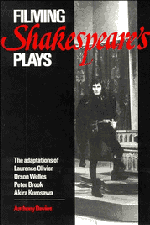 Filming Shakespeare's Plays
Filming Shakespeare's Plays Book contents
- Frontmatter
- Contents
- List of illustrations
- Preface
- Acknowledgements
- Introduction
- 1 Theatrical and cinematic space
- 2 Laurence Olivier's HENRY V
- 3 Laurence Olivier's HAMLET
- 4 Laurence Olivier's RICHARD III
- 5 Orson Welles's MACBETH
- 6 Orson Welles's OTHELLO
- 7 Orson Welles's CHIMES AT MIDNIGHT
- 8 Peter Brook's KING LEAR and Akira Kurosawa's THRONE OF BLOOD
- 9 The film actor
- Conclusion
- Notes
- Select filmography
- Bibliography
- Index
7 - Orson Welles's CHIMES AT MIDNIGHT
Published online by Cambridge University Press: 01 June 2011
- Frontmatter
- Contents
- List of illustrations
- Preface
- Acknowledgements
- Introduction
- 1 Theatrical and cinematic space
- 2 Laurence Olivier's HENRY V
- 3 Laurence Olivier's HAMLET
- 4 Laurence Olivier's RICHARD III
- 5 Orson Welles's MACBETH
- 6 Orson Welles's OTHELLO
- 7 Orson Welles's CHIMES AT MIDNIGHT
- 8 Peter Brook's KING LEAR and Akira Kurosawa's THRONE OF BLOOD
- 9 The film actor
- Conclusion
- Notes
- Select filmography
- Bibliography
- Index
Summary
Chimes at Midnight and Olivier's Hamlet are the two films which most successfully fuse the elements of theatre and cinema in the field of Shakespearean film. Some adaptations have more powerful moments and some are technically more polished, but these two films sustain an equipoise in their spatial strategies which makes them organic cinema, while still allowing the actor to shape delivery and to establish character. We have traced something of Olivier's move from theatre to cinema. The theatrical dimensions which surface in Welles's films, and which emerge fully in Chimes at Midnight, are most clearly traced if the film is seen in relation to the Welles canon, and then in relation to the two Shakespeare films that precede it.
Most critical surveys of Welles's films discern a clear division between the Welles of Citizen Kane with its forging of new dimensions in the language of the cinema, and the Welles whose camera sought to explore the contemplative and elegiac potentials of cinematic expression.
Clearly, there is the temptation to expect and so to seek a division between the early Welles and the late Welles: the period of vigorous brilliance and that of autumnal mellowness. Mike Prokosch, in an article on Welles published in 1971, sees Touch of Evil (1958) as marking a significant turning point which makes a neat chronological division between those films ‘that analyse personality through dramatic conflict’ and those that ‘create atmospheres that speak for their heroes’.
- Type
- Chapter
- Information
- Filming Shakespeare's PlaysThe Adaptations of Laurence Olivier, Orson Welles, Peter Brook and Akira Kurosawa, pp. 119 - 142Publisher: Cambridge University PressPrint publication year: 1988


